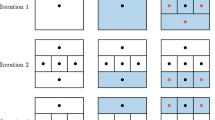Abstract
The solution of a large-scale linear, integer, or mixed integer programming problem is often facilitated by the exploitation of special structure in the model. This paper presents heuristic algorithms for identifying embedded network rows within the coefficient matrix of such models. The problem of identifying a maximum-size embedded pure network is shown to be among the class of NP-hard problems. The polynomially-bounded, efficient algorithms presented here do not guarantee network sets of maximum size. However, upper bounds on the size of the maximum network set are developed and used to show that our algorithms identify embedded networks of close to maximum size. Computational tests with large-scale, real-world models are presented.
Similar content being viewed by others
References
R. Bixby and W. Cunningham, “Converting linear programs to network problems“,Mathematics of Operations Research 5 (1980) 321–357.
A. Brearly, G. Mitra and H. Williams. Analysis of mathematical programming models prior to applying the simplex algorithm”,Mathematical Programming 8 (1975) 54–83.
G. Brown and D. Thomen, “Automatic identification of generalized upper bounds in large-scale optimization models”Management Science 26 (1980) 1166–1184.
G. Brown and R. McBride, “Extracting embedded generalized network problems from general LP problems”, paper presented at ORSA/TIMS (Houston, TX, September 1981).
G. Brown and W. Wright, “Automatic identification of embedded structure in large-scale optimization models”, in: H. Greenberg and J. Maybee, eds,Computer-assisted analysis and model simplification (Academic Press, New York, 1981) (proceedings from Boulder, CO, March 28, 1980) pp. 369–388.
G. Dantzig and R. Van Slyke, “Generalized upper bounding techniques”,Journal of Computer and System Sciences 1 (1967) 213–226.
M. Garey and D. Johnson,Computers and intractability: A guide to the theory of NP-completeness (W.H. Freeman and Company, San Francisco, 1979).
G. Graves and R. McBride, “The factorization approach to large-scale linear programming”,Mathematical Programming 10 (1976) 91–110.
G. Graves and T. Van Roy, “Decomposition for large-scale linear and mixed integer linear programming”, UCLA Technical Report (Los Angeles, CA, November 1979).
H. Greenberg and D. Rarick, “Determining GUB sets via an invert agenda algorithm”Mathematical Programming 7 (1974) 240–244.
R. McBride. “Linear programming with linked lists and automatic guberization”, Working Paper No. 8175, University of Southern California, School of Business (Los Angeles, CA, July 1975).
R. McBride, “Solving linear programs with network factorization”, Working Paper, University of Southern California, School of Business (Los Angeles, CA, September, 1982).
V. Klee, “Combinatorial optimization: What is the state of the art”.Mathematics of Operations Research 5 (1980) 1–26.
J. Musalem, “Converting linear models to network models” Ph.D. Dissertation, UCLA (Los Angeles, CA, January 1980).
L. Schrage, “Some comments on hidden structure in linear programs”, in: H. Greenberg and J. Maybee, eds.,Computer-assisted analysis and model simplification (Academic Press, New York, 1981) (proceedings from Boulder, CO, March 28, 1980) pp. 389–395.
S. Senju and Y. Toyoda, “An approach to linear programming with 0–1 variables”.Management Science 15 (1968) B196-B207.
D. Thomen, “Automatic factorization of generalized upper bounds in large-scale optimization problems”, M.S. Thesis, Naval Postgraduate School (Monterey, CA September, 1979).
W. Wright, “Automatic identification of network rows in large-scale optimization models,” M.S. Thesis, Naval Postgraduate School (Monterey, CA, September 1980).
Author information
Authors and Affiliations
Rights and permissions
About this article
Cite this article
Brown, G.G., Wright, W.G. Automatic identification of embedded network rows in large-scale optimization models. Mathematical Programming 29, 41–56 (1984). https://doi.org/10.1007/BF02591728
Received:
Revised:
Issue Date:
DOI: https://doi.org/10.1007/BF02591728




